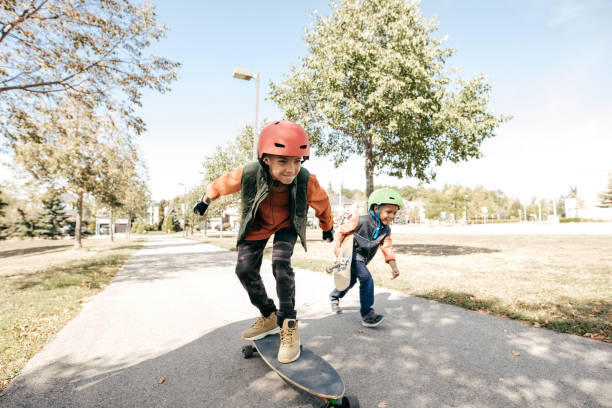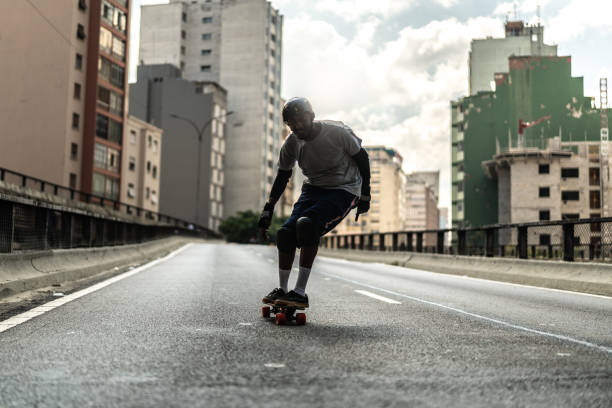Skateboarding first became popular among people of all ages in the US around the 1950s and has since grown in popularity worldwide. Skateboarding businesses have been inspired to continue innovating and creating a wide variety of skateboards as a result of people’s growing enthusiasm for this sport.
So, if you’re just starting out, you might feel confused and overwhelmed about which option to pick. We’ll give you details on the most well-liked skateboard designs in this article. To learn more about them, if you’re ready, continue reading slowly.
Table of Contents
What is a Skateboard?
A skater uses a skateboard as a means of transportation or for performing tricks. Skateboards can be made of wood, composite material, or another material. They have two pairs of axles and four wheels altogether. Skateboarding is powered by your feet, but there are also electric skateboards that don’t need to be kicked or pumped.
Components of a Skateboard
A complete skateboard is made up of three basic parts:
Deck
The wooden or composite material platform that the trucks are mounted on and that you stand on is called a skateboard deck. The topside of the deck is typically covered with grip tape, which is applied in various ways depending on the skater’s preference, to ensure that your shoes don’t slide off the board. Skateboards typically have an artistic or plain bottom design. The deck size is dependent on the skater’s height, weight, shoe size, and riding preferences.
Trucks
Trucks are the axles that hold the wheels, and each truck is fastened to the board with four bolts. You can control how loosely or tightly the trucks move by changing the kingpin’s tension and releasing or applying pressure to the bushings. Depending on the board, rider, and usage, this controls how simple or difficult it is to turn. The width of your skateboard and your trucks should be similar. Your wheel diameter and riding preferences will determine the height of your trucks.
Wheels
Each skateboard has two trucks with two wheels each, totaling four wheels. Smaller wheels (50–53 mm) are used by street and trick skaters because they are easier to turn; average wheels (54–59 mm) work best on vertical (vert) ramps and are good options for beginners, and large wheels (60 mm or more) are used for longboards and rougher terrains. The wheels rotate via bearings (two per wheel for a total of eight per board) and are rated using the ABEC (Annular Bearing Engineering Committee) rating; sizes 1, 3, 5, 7, and 9 are considered to be of higher quality and precision. Additionally, skateboard wheels come in a variety of hardness ratings, with soft wheels being better for faster downhill skating and higher speeds and hard wheels being better for trick skating.
4 Types of Longboard Skateboards
According to their intended use, construction, and general appearance, longboard skateboards are available in a wide variety of styles.
Classic Longboards
This traditional longboard has a wider deck and is longer than 33 inches. Longboards are better for precise road carving than tricks, but they also handle wide turns more easily.
Downhill Longboards
Similar in size to a traditional longboard, a downhill longboard has a lower deck height. The notches in these boards allow for the use of shorter trucks and taller wheels that extend above the deck height. Many have drop-through decks, which means the deck has openings so that the truck’s top can sit higher than the board, further reducing the overall height. On a downhill track, you can travel up to 45 miles per hour thanks to the combination of this keeping it low to the ground.
Pintail Longboards
These longboards have a classic appearance, but their pointed oval shape allows the wheels to rest outside the deck. You can move more quickly and make sharper turns thanks to this.
Twin Tip Longboards
Downhill longboards and twin-tip longboards are nearly interchangeable. Each of them has a low stance and wheel cutouts. A downhill board may have a nose or tail that is shaped differently from the other end, whereas a twin-tip board is identical on both sides.

8 Types of Shortboard Skateboards
Skateboards come in more varieties of shortboards than longboards, so choosing the right one for your style is crucial.
Cruiser Skateboards
A cruiser is a good choice if you want to use your skateboard for transportation. These skateboards resemble street skateboards but have thicker decks and bigger, softer wheels that make them better for faster speeds and rougher surfaces. Another option for a cruiser’s tail is a kick tail, which enables tricks like ollies and kickflips that let you pop off the ground to maneuver around curbs and other obstacles.
Double Kick Skateboards
The popsicle shape of the street board is used in a double-kick skateboard, but the nose and tail of the skateboard are both tipped up, making it simpler to freestyle and perform tricks while riding. For the hard landing that occurs when you and the board launch into the air, they have thicker decks and harder wheels.
Mini Skateboards
These are the smallest skateboards, and because of their size, they are frequently used by younger beginners. Because of their portability, mini-boards are also popular with older and more experienced skaters, especially when used while traveling or when space is at a premium.
Mini Cruiser Skateboards
Combining a cruiser and a mini, a mini cruiser board has a smaller, narrower deck and larger, softer wheels. They are also beneficial for new riders, especially kids because the larger wheels offer stability and the size is appropriate for smaller riders.
Old-school Skateboards
An old-school skateboard resembles a surfboard in appearance; the nose is pointed and the tail is flat.
Penny Or Nickle Skateboards
These lightweight, transportable plastic shortboards are shorter than conventional models and made of plastic. Although there are street and mini cruiser variations, the majority are in the shape of an old school board.
Steep Kick Skateboards
Steep kick skateboards are better for more experienced riders to perform skateboard tricks that require higher lifts when jumping off the ground because they have taller and steeper ends.
Street Skateboards
This type of skateboard is adaptable. They are simple to ride in bowls and on the street, so skaters take them to and from the skatepark. Although there are variations on that theme, they all have rounded tails and noses that are similar in shape to popsicle sticks. These boards are also thinner than other models.

Other Types of Skateboards
The Carve Skateboard
The carved skateboard’s design allows for effortless pumping to produce its own speed.
It was made to behave on flat ground like a surfboard would on the face of a wave.
It’s a preferred plank for riding a bowl and a great choice for practicing turns and deep carves.
Due to the way in which it combines the qualities of both cruisers and longboards, this hybrid skateboard design is growing in popularity.
The Electric Skateboard
The most recent addition to the variety of skateboard styles and types is the electric skateboard.
The paddle longboard was one of the earliest iterations of the pre-eSkate era. It was an off-road deck with large all-terrain wheels and a long flexible pole with a rubber ball at the end used to propel, steer, and slow the board.
The design ultimately evolved into an electric skateboard with a small motor. Young urban commuters and gadget nerds are the design’s intended target audience.
With speeds up to 15 mph, these motorized skateboards can travel five miles.
To engage the front and rear pads, a skater simply needs to move forward and backward on the deck.
How to Choose a Skateboard
When choosing your skateboard, you should consider a number of different factors because there are so many different types and designs of skateboards. Here are a few things you should consider when trying to choose the right skateboard:
Riding Style
Different boards are required for various skateboarding techniques. Start with a shortboard and then focus on your options if you enjoy performing tricks at the skatepark with your friends. A longboard is more appropriate if you like to cruise over long distances and engage in more street carving.
Shoe Size
Choose a deck that is 8 to 8.5 inches wide if your shoe size is 9.5 or larger. A full-sized standard skateboard with a 7.5-inch deck width will fit you if you have adult shoes that are at least size 8. For a deck that is 7.25–7.375 inches wide, shoe sizes 6–8 will work. A 7-inch-wide deck can be used by someone with a shoe size of 2–5. A 6.5–6.75 inch deck should be used for a size 1 or smaller.
Usage
Consider how often and where you will use your skateboard before purchasing one of the many boards available. If you’re planning a trip and want to ride a skateboard when you get there, think about getting a mini-board or another travel-friendly option. If space is not a concern, you could instead purchase a longboard for cruising or slaloming.
Your Height
Anyone 5 feet, 3 inches, or taller will fit perfectly on a full-sized regular skateboard. A mid-sized skateboard with a deck width of 7.25–7.375 inches should be purchased by a skater who is between 4 feet, 5 inches, and 5 feet, 2 inches tall. Skaters between 3 feet, 5 inches, and 4 feet, and 4 inches tall can purchase a mini-sized skateboard with a 7-inch deck width, while those under 3 feet, 5 inches tall should purchase a micro-sized skateboard with a deck that is 6.5–6.75 inches wide.
Skateboarders with professional experience frequently work in skate shops. If you have the chance, ask a staff member at your neighborhood skate shop for advice on the ideal board width, wheel size, and other specifications.
Conclusion
The quality and build of the board, whether you choose mini, old school, or longboards, are what really matter. Work your way up to a downhill professional skateboarding level by starting small and simple.
No matter what you choose, always follow the advised safety precautions.

Comments are closed, but trackbacks and pingbacks are open.